Support the Foundation’s efforts to designate the
Smiley-Brackett Cottage a Local Landmark!

UPDATE: The Saratoga Springs Preservation Foundation is pleased to announce that on Tuesday, December 21, 2021, the City Council unanimously voted to accept the proposed zoning amendment to designate 166 Excelsior Avenue, the Smiley-Brackett Cottage, a Local Landmark.
The Saratoga Springs Preservation Foundation has proposed that 166 Excelsior Avenue be designated a Local Landmark. The City Council unanimously voted to accept the review of the proposed zoning amendment to designate 166 Excelsior Avenue a Local Landmark. The Design Review Commission and the Planning Board are required to provide an advisory opinion on the proposed zoning amendment. Both the Design Review Commission and the Planning Board recently gave strong favorable opinions. It now returns to the City Council for consideration and vote. To view the Foundation’s presentation about Smiley-Brackett Cottage CLICK HERE.
The property is not only worthy of this designation because of its architecture, but also for those who lived there – Sarah F. Smiley and Charles Brackett. It is currently not located in a Historic District or an Architectural Review District, therefore there is NO review for demolition or new construction. The Foundation is seeking this designation to preserve the history of this property for future generations.
Tuesday, December 21, 2021 at 6:55 p.m. a public hearing will be held before the City Council meeting to allow those who wish to speak in favor or against the proposed Local Landmark designation of the Smiley-Brackett Cottage located at 166 Excelsior Avenue. I encourage you to come speak in favor or write a letter of support to public.comment@saratoga-springs.org.
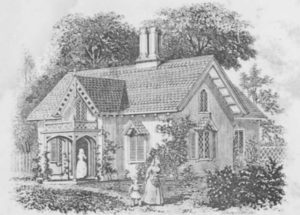
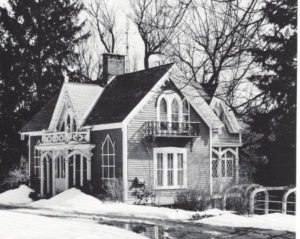
1850 Depiction from AJ Downing’s “The Architecture of Country Houses” (left)
1991, Smiley-Brackett Cottage, photo by Carol Christensen (right)
This unique property is deserving of recognition and worthy of being preserved in the future. In October 1872, Sarah F. Smiley acquired a 60’ x 120’ lot from Henry Lawrence in Excelsior Park and built a Gothic Revival Cottage.
The Gothic Revival style was popularized by Andrew Jackson Downing. He published Cottage Residences (1842) and The Architecture of Country Houses (1850). Alexander Jackson Davis designed and drew the illustrations featured. Although the architect of Miss Smiley’s cottage is unknown, it is clearly influenced by Downing’s book.
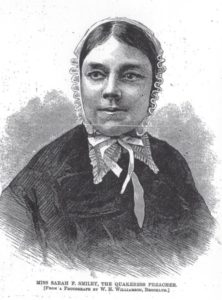 Sarah was born in 1830 in Maine. She came from a well-known Quaker family – her father and brothers founded the Mohonk Mountain House in the Catskills in 1870. After the Civil War Sarah traveled south to be a relief worker, where she spoke to Black and white audiences. “I went to relieve human suffering,” Sarah said of her time as a relief worker in the South. She traveled to Virginia and North Carolina aiding Quakers and organizing schools and libraries. She helped to start a school for 1,000 free Black adults and children in Richmond, Virginia.
Sarah was born in 1830 in Maine. She came from a well-known Quaker family – her father and brothers founded the Mohonk Mountain House in the Catskills in 1870. After the Civil War Sarah traveled south to be a relief worker, where she spoke to Black and white audiences. “I went to relieve human suffering,” Sarah said of her time as a relief worker in the South. She traveled to Virginia and North Carolina aiding Quakers and organizing schools and libraries. She helped to start a school for 1,000 free Black adults and children in Richmond, Virginia.
In 1872, she preached before a mixed audience of men and women at the Presbyterian Church in Brooklyn, New York. The event was described by the February 11, 1872 New York Herald – “Dr. Cuyler had invited a sweet little duck of an unbaptized Quaker, Miss Smiley (happy name!) to preach in his church.” According to Harper’s Weekly, Miss Smiley and Reverend Cuyler were criticized. “To teach and to exhort, or to lead in prayer in public and promiscuous assemblies is clearly forbidden to women in the Holy Oracles.”
While she was criticized at first for speaking in front of a mixed audience of men and women, she soon was asked to speak all across the country and abroad, including London and Cuba. She was controversial for insisting that women could study the scriptures themselves, without the help of men. Sarah founded a home Bible study program for women. She was an author of five books – some of which are published today. She also accumulated a library of over 5,000 volumes of books that she later donated. Upon her death in 1917, the cottage was left to The Society for the Home Study of Holy Scripture and Church History, a group she founded to promote religious study by mail.
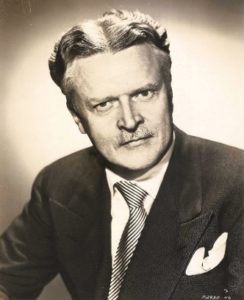 In January 1921, Charles W. Brackett, purchased the cottage from the Society for the Home Study of Scripture and Church History, which he had rented since 1919. He had previously purchased extensive property along Excelsior Avenue surrounding the cottage in June 1920.
In January 1921, Charles W. Brackett, purchased the cottage from the Society for the Home Study of Scripture and Church History, which he had rented since 1919. He had previously purchased extensive property along Excelsior Avenue surrounding the cottage in June 1920.
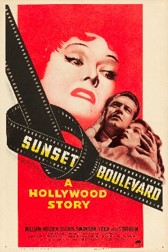 Charles was the son of Senator Edgar T. Brackett. He was educated at Williams College and Harvard Law School. He joined the Allied Expeditionary Force during World War I and was awarded the French Medal of Honor. He wrote several novels and became the New Yorker magazine drama critic. He became a screenwriter. He partnered with Billy Wilder on 16 films including Sunset Boulevard, The Lost Weekend and many others. Together they won Academy Awards for the scripts of Sunset Boulevard and The Lost Weekend. In 1953, his script for Titanic won him another Academy Award. He received an Honorary Oscar for Lifetime Achievement in 1958.
Charles was the son of Senator Edgar T. Brackett. He was educated at Williams College and Harvard Law School. He joined the Allied Expeditionary Force during World War I and was awarded the French Medal of Honor. He wrote several novels and became the New Yorker magazine drama critic. He became a screenwriter. He partnered with Billy Wilder on 16 films including Sunset Boulevard, The Lost Weekend and many others. Together they won Academy Awards for the scripts of Sunset Boulevard and The Lost Weekend. In 1953, his script for Titanic won him another Academy Award. He received an Honorary Oscar for Lifetime Achievement in 1958.
In December 1968, prior to his death in March of 1969, Charles sold the property to Daniel M. Jewett, Jr.
The Saratoga Springs Preservation Foundation listed the property on its endangered property list in 1998. The Foundation over the past 20 years has attempted to assist the owner to no avail. The Foundation sought a Determination of Eligibility for individual listing on the National Register of Historic Places and it was deemed eligible for individual listing on the National Register of Historic Places.

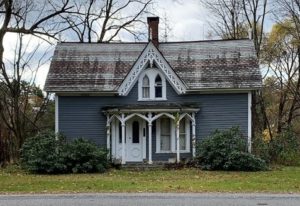
The condition of the property continues to deteriorate and there is concern that the heirs of the current owner will not have an interest in preserving the structures.
As outlined, the architecture and the associations of this property are of high historical relevance deserving of recognition and the protection and oversight to ensure it will be preserved for next generations.
There is no other individual property that is worthy of this honor and we hope you will join us in support of this designation.
